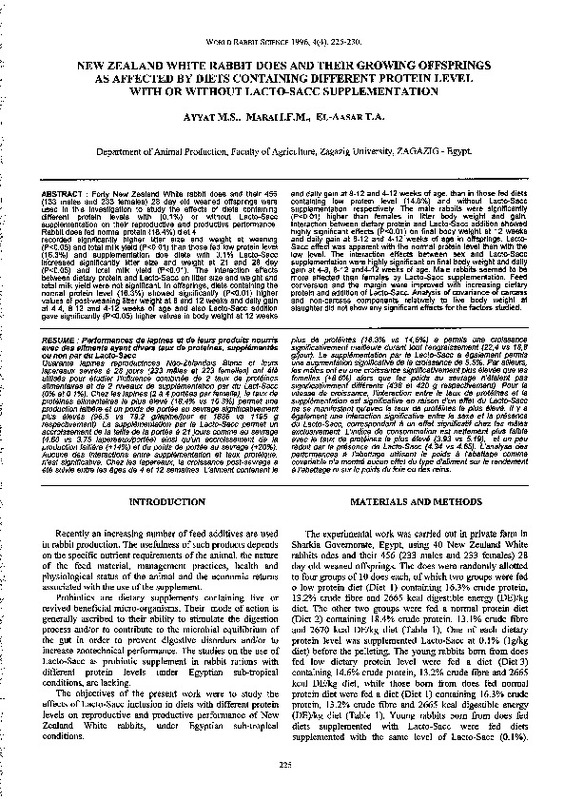JavaScript is disabled for your browser. Some features of this site may not work without it.
Buscar en RiuNet
Listar
Mi cuenta
Estadísticas
Ayuda RiuNet
Admin. UPV
NEW ZEALAND WHITE RABBIT DOES AND THEIR GROWING OFFSPRINGS AS AFFECTED BY DIETS CONTAINING DIFFERENT PROTEIN LEVEL WITH OR WITHOUT LACTO-SACC SUPPLEMENTATION
Mostrar el registro sencillo del ítem
Ficheros en el ítem
| dc.contributor.author | AYYAT, M.S.
|
|
| dc.contributor.author | MARAI, I.F.M.
|
|
| dc.contributor.author | EL-AASAR, T.A.
|
|
| dc.date.accessioned | 2011-03-21T10:25:04Z | |
| dc.date.available | 2011-03-21T10:25:04Z | |
| dc.date.issued | 1996 | |
| dc.identifier.issn | 1257-5011 | |
| dc.identifier.uri | http://hdl.handle.net/10251/10452 | |
| dc.description.abstract | [EN] Forty New Zealand White rabbit does and their 456 (133 males and 233 females) 28 day old weaned offsprings were used in this investigation to study the effects of diets containing different protein levels with (0.1 %) or without Lacto-Sacc supplementation on their reproductiva and productiva performance. Rabbit does fed normal protein (18.4%) diet 4 recordad significantly higher litter size and weight at weaning (P<0.05) and total milk yield (P<0.01) than those fed low protein level (16.3%) and supplementation doe diets with 0.1% Lacto-Sacc in·creased significantly litter size and weight at 21 and 28 day (P<0.05) and total milk yield (P<0.01 ). The interaction effects between dietary protein and Lacto-Sacc on litter size and weight and total milk yield were not significant. In offsprings, diets containing the normal protein level (16.3%) showed significantly (P<0.01) higher values of post-weaning litter weight at 8 and 12 weeks and daily gain at 4-4, 8-12 and 4-12 weeks of age and also Lacto-Sacc addition gave significantly (P<0.05) higher values in body weight at 12 weeks and daily gain at 8-12 and 4-12 weeks of age, than in those fed diets containing low protein level (14.8%) and without Lacto-Sacc supplementation, respectively. The male rabbits were significantly (P<0.01) higher than females in litter body weight and gain. lnteraction between dietary protein and Lacto-Sacc addition showed highly significant effects (P<0.01) on final body weight at 12 weeks and daily gain at 8-12 and 4-12 weeks of age in offsprings. LactoSacc effect was apparent with the normal protein level than with the low level. The interaction effects between sex and Lacto-Sacc supplementation were highly significant on final body weight and daily gain at 4-8, 8-12 and4-12 weeks of age. Male rabbits seemed to be more affected than females by Lacto-Sacc supplementation. Feed conversion and the margin were improved with increasing dietary protein and addition of Lacto-Sacc. Analysis of covariance of carcass and non-carcass components relatively to live body weight at slaughter did not show any significant effects for the factors studied. | es_ES |
| dc.description.abstract | [FR] Quarante lapines reproductrices Néo-Zélandais Blanc et leurs lapereaux sevrés a 28 jours (233 males et 223 feme/les) ont été utilisés pour étudier l'influence combinée de 2 taux de protéines alimentaires et de 2 niveaux de supplémentation par du Lact-Sacc (0% et O. 1%). Chez les /apines (2 a 4 portées par feme/le), le taux de protéines a/imentaires le plus élevé (18.4% vs 16.3%) permet une production laitiere et un poids de portée au sevrage significativement plus élevés (96.5 vs 79.2 g/lapineljour et 1886 vs 1195 g respectivement). La supplémentation par le Lacto-Sacc permet un accroissement de la taille de la portée a 21 jours comme au sevrage (4.60 vs 3.75 lapereauxlportée) ainsi qu'un accroissement de la production laitiere (+14%) et du poids de portée au sevrage (+20%). Aucune des interactions entre supplémentation et taux protéique, n'est significative. Chez les lapereaux, la croissance post-sevrage a été suivie entre les §ges de 4 et 12 semaines. L'aliment contenant le plus de protéines (16,3% vs 14,6%) a permis une croissance significativement meil/eure durant tout f'engraissement (22,4 vs 18,8 gljour). La supplémentation par le Lacto-Sacc a également permis une augmentation significative de la croissance de 5. 5%. Par ail/eurs, les males ont eu une croissance significativement plus élevée que les feme/les (+8,6%) alors que les poids au sevrage n'étaient pas significativement différents (438 et 420 g respectivement). Pour la vitesse de croissance, l'interaction entre le taux de protéines et la supplémentation est significative en raison d'un effet du Lacto-Sacc ne se manifestant qu'avec le taux de protéines le plus élevé. 11 y a également une interaction significative entre le sexe et la présence du Lacto-Sacc, correspondant a un effet significatif chez les m§/es exclusivement. L'indice de consommation est nettement plus faible avec le taux de protéines le plus élevé (3.93 vs 5.19), et un peu réduit par la présence de Lacto-Sacc (4.34 vs 4.65). L'analyse des performances a f'abattage utilisant le poids a f'abattage comme covariable n'a montré aucun effet du type d'aliment sur le rendement a l'abattage ni sur le poids du foie ou des reins. | |
| dc.language | Inglés | es_ES |
| dc.publisher | World Rabbit Science. ICTA. UPV | es_ES |
| dc.relation.ispartof | World Rabbit Science | |
| dc.rights | Reserva de todos los derechos | es_ES |
| dc.title | NEW ZEALAND WHITE RABBIT DOES AND THEIR GROWING OFFSPRINGS AS AFFECTED BY DIETS CONTAINING DIFFERENT PROTEIN LEVEL WITH OR WITHOUT LACTO-SACC SUPPLEMENTATION | es_ES |
| dc.type | Artículo | es_ES |
| dc.date.updated | 2011-03-21T09:59:18Z | |
| dc.identifier.doi | 10.4995/wrs.1996.299 | es_ES |
| dc.rights.accessRights | Abierto | es_ES |
| dc.description.bibliographicCitation | Ayyat, M.; Marai, I.; El-Aasar, T. (1996). NEW ZEALAND WHITE RABBIT DOES AND THEIR GROWING OFFSPRINGS AS AFFECTED BY DIETS CONTAINING DIFFERENT PROTEIN LEVEL WITH OR WITHOUT LACTO-SACC SUPPLEMENTATION. World Rabbit Science. 04(4). https://doi.org/10.4995/wrs.1996.299 | es_ES |
| dc.description.accrualMethod | SWORD | es_ES |
| dc.relation.publisherversion | https://doi.org/10.4995/wrs.1996.299 | es_ES |
| dc.description.volume | 04 | |
| dc.description.issue | 4 | |
| dc.identifier.eissn | 1989-8886 | es_ES |








